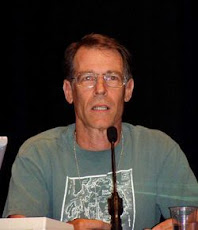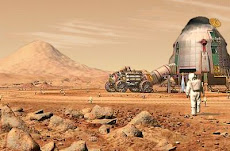
By Marc Kaufman Washington Post Staff Writer
Saturday, September 4, 2010; A1
Thirty-four years after NASA's Viking missions to Mars sent back results interpreted to mean there was no organic material - and consequently no life - on the planet, new research has concluded that organic material was found after all.
The finding does not bring scientists closer to discovering life on Mars, researchers say, but it does open the door to a greater likelihood that life exists, or once existed, on the planet.
"We can now say there is organic material on Mars, and that the Viking organics experiment that didn't find any had most likely destroyed what was there during the testing," said Rafael Navarro-Gonzalez of the National Autonomous University of Mexico.
"For decades NASA's mantra for Mars was 'follow the water' in the search for life, and we know today that water has been all over the planet," he said. "Now the motto is 'follow the organics' in the search for life."
The original 1976 finding of "no organics" was controversial from the start because organic matter - complex carbons with oxygen and hydrogen, which are the basis of life on Earth - is known to fall on Mars, as onto Earth and elsewhere, all the time. Certain kinds of meteorites are rich in organics, as is the interstellar dust that falls from deep space and blankets planets.
The new results, published in the -Journal of Geophysical Research of Planets and highlighted Friday in a NASA news release, flow directly from a discovery made by NASA's Phoenix lander in 2008.
Mary Voytek, senior scientist for astrobiology at NASA, said the findings demonstrate the ever-present risk of reaching "false negatives" in space based on limitations of the equipment used and of the scientists' understanding of conditions beyond Earth.
She said the research does not fully knock down the original "no-organics" conclusion because the new experiment was done using desert soil from Earth, which might behave differently from seemingly similar Martian dirt. But she said the research does put another "significant chink" in the no-organics position.
The new research examined the effects on organics of a compound that Phoenix unexpectedly found at its landing site on northern Mars.
The discovery of the highly reactive chemical perchlorate led NASA's Christopher McKay, an astrobiologist at the Ames Research Center, and Navarro-Gonzalez to test whether the perchlorate had skewed the Viking results that showed no sign of organic material on Mars.
The two researchers combined magnesium perchlorate with soil from the most Mars-like environment on Earth - the Atacama Desert in Chile - and heated the sample in the same way that it was heated by Viking instruments on Mars.
The researchers found that the small amount of organic material known to be in the Atacama soil was detectable when mixed with the perchlorate at low temperatures but was broken up into water and carbon dioxide when heated alongside the perchlorate. The Viking experiment had heated the sample to a similarly high temperature.
Perchlorate, which consists of chlorine and oxygen, actively absorbs electrons from surrounding compounds when heated. "It could sit there in the Martian soil with organics around it for billions of years and not break them down," McKay said. "But when you heat the soil to check for organics, the perchlorate destroys them rapidly."
In addition, the researchers found evidence of the organic compound chloromethane after they heated the Atacama soil with perchlorate. That compound had been detected during the organics experiments at both Viking landing sites but had been written off as a contaminant from Earth because it is in cleaning fluids.
Navarro-Gonzalez said his team ran the experiment many times and always produced some form of chloromethane, leading to the conclusion that it was being formed by the combining of the perchlorate with some form of organic Mars material.
"The big lesson here, and the great importance of this finding, is that we have to know what we're looking for and how we can find it," Voytek said. "It shows that we could actually uncover life on Mars and not know it."
That is what some believe already happened on Mars. A life-detection experiment on both Viking landers gave a positive signal that something in the soil was metabolizing a food source introduced and a negative signal in the control experiment. The principle investigator of that experiment, Gilbert Levin, has argued for more than 30 years that Viking did, indeed, find life.
It was the no-organics conclusion of a subsequent Viking experiment that convinced scientists that Levin's test had detected a non-biological chemical reaction. Although many planetary scientists have remained convinced that Levin did not find life, the increasingly apparent problems with the no-organics experiment are leading some to reconsider.
The new paper will also be important for NASA's 2011 Mars Science Laboratory mission, which is designed specifically to find organic material on the planet. The mission's Curiosity rover has some of the same high-temperature equipment to detect organics that Viking had, although it also has a secondary experiment that involves solvents at low temperatures.
Navarro-Gonzalez is on the MSL science team and will bring his new interpretation of Martian chemistry to the effort. Confirming the presence of organic material on the Martian surface and learning about its properties, he said, would add enormous impetus to the search for possible Martian life.
Here is the update from the article below:
Recent experiments in Chile could provide hope that living microbes may yet exist on Mars, despite data collected by NASA’s Viking landers in 1976 that have generally been interpreted as showing no evidence of life.The new studies, conducted by Rafael Navarro-Gonzalez and a geophysical team from the National Autonomous University of Mexico (UNAM), suggest that the Viking data have been misinterpreted and that carbon-rich organic molecules may be present on Mars after all.The renewed interest in reviewing the Viking data stems from the discovery of the chlorine-containing chemical perchlorate by the Phoenix Mars lander in 2008. The perchlorate ion, comprising chlorine and oxygen, was detected by the spacecraft’s wet chemistry laboratory during the first-ever analysis of this type of Martian soil. The analysis of three samples — two from the surface and one from 5 cm. depth — revealed the presence of perchlorate, as well as a slightly alkaline soil and low levels of salts.Dry LandIn response, researchers from UNAM visited Yungay in the heart of Chile’s Atacama Desert to conduct experiments on soils found in an environment similar to that on Mars. With an average rainfall of less than 0.004 in./0.01 cm. per year, the Atacama is the driest place on Earth and includes zones that are thought to have had no rain for approximately 400 years. “These soils have extremely low levels of culturable bacteria, low organic concentrations, and the presence of a non-chirally [identical] specific oxidant,” say the researchers, who add that the “search for organics in this soil sample has been thoroughly investigated using the Viking and Phoenix landers protocols.”In the experiment, the researchers mixed the soil with perchlorate and heated it to produce carbon dioxide as well as traces of chloromethane and dichloromethane. These same gases were also detected in the chemical reactions after the Viking landers heated the Martian soil, suggesting that not only perchlorate but also organics may have been present. Following the Viking landings, the same chlorine-containing organic compounds were thought to be contaminants carried on the spacecraft.Peter Smith, the principal investigator of the Phoenix Mars Mission at the University of Arizona, says the misinterpretation of the Viking results may have effectively put researchers on a different track for the past 30 years. “The perchlorate seen out of the results from 1976 was dismissed as contaminants from the cleaning agents used on Viking,” he says. As a result of the new evidence, he says that when NASA’s Mars Science Laboratory (MSL) mission reaches the planet in 2012, “I predict we will fully measure organics on Mars at the 10 [parts per million] level.”Commenting at the American Institute of Aeronautics and Astronautics Space 2010 conference in Anaheim, Calif., Smith offers a note of caution. “I don’t think we’ll find out for sure until we go there for ourselves, and we get samples from the right places. I don’t think there’s anything more exciting than going to Mars and bringing back samples. That will be the capstone of the 21st century in my view.”The MSL Curiosity rover is being tested at NASA’s Jet Propulsion Laboratory in California and is scheduled for launch in late 2011 and for a landing on Mars in August 2012. The largest rover ever sent to the planet, Curiosity will be configured with 10 instruments to search for environments where life might have existed and the capacity of those environments to preserve evidence of past life.
http://www.aviationweek.com/aw/generic/story_channel.jsp?channel=space&id=news%2Fasd%2F2010%2F09%2F08%2F11.xml&headline=Fresh+Research+Rekindles+Life+On+Mars+Debate



